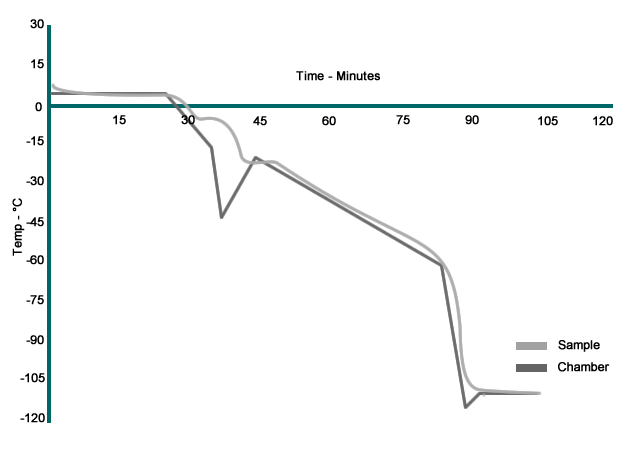
What is Cooling Rate?
Shirley Pan, Xiaotian Deng
2018-06-28 00:51:23 in A Brief Overview of Cryopreservation
( Copyright © 2018 Fibulas, Inc. All content and articles here are produced by our team. Please support our research effort and do not copy or translate the content without permission. )
Cooling rate in cryopreservation is usually referred to the speed at which temperature drops until it reaches terminal temperature. In the cryopreservation process, cooling rate can be a constant (a relatively stable rate, because strictly speaking, even using a programmable freezer cannot give you a constant freezing rate due to phase change in the water content of the sample), or a varying number. In 1963, Mazur published a paper, explaining that the rate of temperature change was important because it controlled the transport of water in and out of the membrane [1].

(This chart above is qualitatively reproduced based on original chart from Cryopreservation and Freeze-drying Protocols [2])
Many controlled-rate freezer users believe that they can achieve constant rate freezing by using their expansive devices. However, it is not really the case. Look at the chart above [2], which shows two temperature measures during a controlled-rate freezing process. The lighter grey color is the chamber temperature, while the darker line shows the sample temperature. It shows that when the sample reach -15°C, it experienced a sudden sharp drop in temperature. At the same time the controlled rate freezer responded to the sudden release of latent heat and increase in temperature. Around -44°C, the sample experienced another sudden change of temperature—this time is an increase in temperature. As a result of this heat exchange, the chamber decreases in temperature. As it is shown in this chart, even with controlled-rate freezer, the cooling rate is still not in very good control. Therefore, unless users have a need to change cooling rates at different stages of the process, control-rate freezers might not be necessary. Due to its complexity in structure and large variation in temperature, controlled-rate freezers are often difficult and expensive to maintain.
There is a consensus that for successful cryopreservation, the temperature range from 0°C to -40°C is critical. In this temperature range, samples change from liquid to solid, and as temperature decreases, the biochemical activity inside the cells becomes largely suppressed. ATCC recommends optimal cooling rate of -1°C/min to -3°C/min, which is a protocol followed in many labs. This golden standard can also be calculated using a model and some assumptions. If the water permeability of the cell membrane is known, and the temperature coefficient of water permeability can be estimated, it is said to be possible to predict the cooling rate on cell survival. Interestingly, the model shows that intracellular freezing is unlikely at -1°C/min, but it is highly probable at a cooling rate of -10°C/min [3].
MetaLocker™ BioFlash Drive™ is a new generation of cryopreservation kit. Just by directly putting the unit with samples into -80°C freezer or vapor phase low temperature nitrogen, user can easy achieve a stable cooling curve within the recommended range by ATCC. Test results show that the recoverability of the sample using MetaLocker™ BioFlash Drive™ is comparable to that of controlled-rate freezers. You can read more about MetaLocker™ BioFlash Drive™ here.
[1] Mazur P(1963) Kinetics of water loss from cells at subzero temperatures and the likelihood of intracellular freezing. J Gen Physiol 47:347 - 369
[2] Day, John G., and G. Stacey. Cryopreservation and Freeze-drying Protocols. Hannover: Humana Press, 2015. Pp493
[3] Rubinsky B, Pegg DE(1988) A mathematical model for the freezing process in biological itssue. Proc R Soc Lond B Bilo Sci 234:343-358 Downloaded from https://academic.oup.com/labmed/article-abstract/14/4/246/2642882 by guest on 21 April 2018
